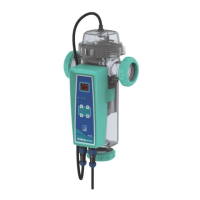3.2.1. Setting the Polarity Period
Although the physical properties of the water used vary depending on geographical regions, it inevitably
contains certain amounts of calcium, magnesium, iron, and other minerals. While the water is cold, these
suspended minerals dissociate from the water during electrolysis, some of them stick to the electrodes in the
chamber. After a certain period, the electrodes are completely covered with the substance called lime. Since the
lime layer is insulating, it complicates the flow of electricity between the electrodes. As a result, chlorine
production efficiency decreases. This lime formed in the electrodes must be cleaned periodically.
This cleaning process; It has the feature to do it automatically by changing the polarization. When the
parameter showing the polarity change time is on the screen (90% indicator LED is on.) By pressing the OK
button once, it is entered into the parameter, and to exit the parameter, the MENU button must be pressed
once. When entering the parameter, the value on the screen starts to flash. Meanwhile, the parameter value is
changed with the direction buttons. When the desired value is given, it is selected and saved with the OK
button.
4 – CLEANING - MAINTENANCE INSTRUCTIONS
4.1. Electrode Cleaning
Although the physical properties of the water used vary depending on geographical regions, it inevitably
contains certain amounts of calcium, magnesium, iron, and other minerals. While the water is cold, these
suspended minerals decompose from water during electrolysis, some of them stick to the electrodes in the
chamber. After a certain period, the electrodes are completely covered with the substance called lime. Since the
lime layer is insulating, they complicate the flow of electricity between the electrodes. As a result, chlorine
production efficiency decreases. This lime formed in the electrodes must be cleaned periodically.
This cleaning process; It has the feature to do it automatically by changing the polarization. However, in
cases where the calcium concentration is too high, this feature may not completely remove the limescale.
Regularly check the lime sediment in the cell and, if necessary, clean the cell manually.
1- Turn off the pump and salt chlorine generator.
2- Close the water inlet and water outlet valves of the electrode cell.
3- Open the threaded electrode head, properly disconnect the electrode cable from the terminal and remove
the electrode from the chamber.
4- Ideally, if the electrode is expected to dry for a day, the lime residue releases itself. During the process, be
careful not to damage the sensitive cover of the electrode and take care. During this process, never hit
with metal material that can scratch the electrode. Pressurized water can be used to dissolve limescale.
5- If the pressurized water could not remove the limescale, you can immerse the electrode in a 20%
hydrochloric acid solution. The terminals at the top of the electrode must not touch the solution.
6- Immediately after cleaning, the electrode must be rinsed with clean water, the place of the terminals must
be carefully dried and reassembled.
Never leave the electrode in acid for more than 5 minutes! Do not scratch the electrode with
metal objects! Soak the acid in water for safety reasons!
4.2. Advices
The bipolar cells of the GSC salt chlorine generator are manufactured using a special technique, providing
an extraordinary period and resistance below the high-quality standards. However, some factors prevent you
from getting the full and longest performance from the electrode. These:
• Run with lime residue on the surface of the electrode
• Excessive chlorine concentration (over 3.00 ppm chlorine is corrosive.)
• Working with high or low pH
• Working with salt-free or high concentration salt
• Operating in water below 10 ° C
• Adding salt while the chlorinator is running
• Injecting pH regulator without placing skimmer or bottom strainer

